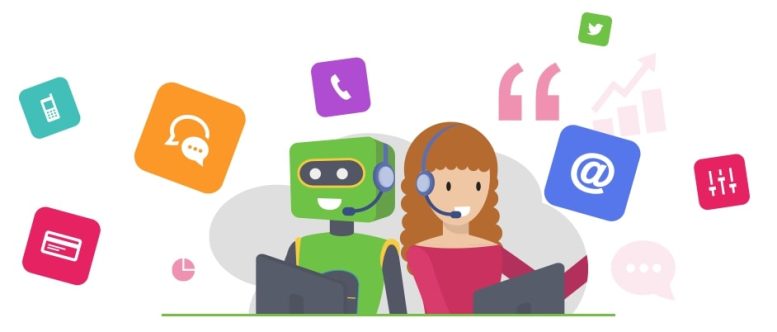How to integrate Chatbots into the customer journey – 3 Tips for Success
 The desire to deploy chatbots in contact centres raises the challenge of how to seamlessly blend human and bot interaction in a way that benefits the customer. Mashud Ahmed of Puzzel considers the challenges and possible solutions for enabling and improving seamless transitions.
The desire to deploy chatbots in contact centres raises the challenge of how to seamlessly blend human and bot interaction in a way that benefits the customer. Mashud Ahmed of Puzzel considers the challenges and possible solutions for enabling and improving seamless transitions.
Many organisations are exploring how to bring chatbots into the customer journey in a meaningful way whilst still ensuring human contact is prevalent. Chatbots can be an excellent addition to the contact centre environment, automating the more mundane tasks and allowing human service agents to focus on higher value activities.
Some circumstances will always necessitate human interaction, these matters often relate to complex and emotive issues that are better handled by trained agents who can react to the customer’s needs. In these situations, a smooth customer transition from automated to assisted dialogue is key. However, finding the balance and bridging between the world of chatbots and human beings, whilst ensuring the customer experience isn’t compromised, can be challenging.
Three Tips for Integrating Chatbots into the customer journey
In today’s ‘always on’ environment, customers expect instant service beyond the traditional 9-5. To meet expectations many businesses are exploring ways to offer customers self-service options and this is where technology can be really effective in assisting customers in an automated way. Modern-day contact centres plan to offer a multi-channel customer experience incorporating a combination of voice, web chat, social media, email and SMS based on the needs of their customer demographic. A high quality chatbot can be seamlessly integrated into this environment and bring value to the customer experience however it’s important to select the right fit for your business. Consider the following:
1) Evaluation is essential – with a plethora of artificial intelligence (AI) applications available on the market it is important to evaluate solutions to understand which one to choose:
– Start by creating a set of standards with which to objectively analyse all solutions to ensure you are not comparing apples to pears
– Include features such as Natural Language Processing (NLP), intent matching, contextual awareness handling, integrations, natural response generation, exception handling, analytics
– Ensure access to good documentation to inform decisions.
For a process to become automated, a lot of work is needed to educate the chatbot so that it has a foundation of knowledge and can self-learn the rest or be tuned further. The evaluation stage is critical in identifying the features and functionality required by the business and ensuring like-for-like objective analysis throughout the evaluation process.
2) Have clear objectives – before launching into the world of AI it’s important to identify the areas the business wants to automate. A chatbot is not a replacement for a human agent but can add value by automating mundane, repetitive tasks. However, to maximise the benefits it is important to narrow the scope to a specific set of tasks and when a more specialised service is required, define a clear handover process to a human agent.
Points to consider when defining your objectives:
– What channel should the chatbot be on? For example, if your organisation has a multi-channel strategy, then web chat or social media may be the ideal starting point as many of the platforms already have integration tools built-in
– What enquiries should the chatbot deal with? Define where the chatbot should sit, for example as a gatekeeper for enquiries it can easily answer and then what should be directed to a human customer service agent
– Define the handover process to the agent – avoid abrupt transitions, keep a record of the chatbot conversation for the agent to review so the customer doesn’t have to repeat themselves and ensure the customer is kept informed during transition.
3) Seamless transition – recent research*revealed that 69% of consumers prefer chatbots for quick communication with brands. It’s clear that speed of response is an important factor for customers so it’s vital that any handover from chatbot to agent doesn’t slow the process. Therefore define a workflow to determine how and when to handover to a human and here are some points to include:
– Triage – define the key information you want your bot to collect so that the call can be routed to the appropriate agent, ensuring valuable agent time is spent on resolving queries rather than gaining information
– Dealing with complex issues – to ensure a swift escalation path consider using a decision tree-based mechanism or a sentiment-based framework that ensures the chatbot collates appropriate information but doesn’t delay the handover to a human and risk irritating the customer further
– Supervisory mechanism – in some scenarios, human intervention may only be needed in a supervisory capacity, the chatbot interfaces with the customer and the human agent oversees the interaction and authorises any actions that need to be executed.
Transformation of the customer journey
The prevalence of smart phones has changed how we consume information, goods or services. We expect instant availability and chatbots are a key component to delivering the real-time, on-demand approach that customers are expecting. However, chatbots, like most technologies, aren’t without their limitations.
By starting small with specific objectives and keeping the customer experience at the centre of the design process, organisations can maximise the benefits of this technology, bridging the gaps between communication channels and helping to deliver a better, speedier experience to customers.
Additional Information

Puzzel builds on 20 years’ heritage. It was one of the first pioneers to develop a cloud-based contact centre. Puzzel also encompasses leading mobile messaging and mobile payments to deliver a flexible and customisable customer interaction platform to meet the needs of today’s omni-channel and mobile environments. Puzzel can be adapted to accommodate from one to several thousand agents using any device, in any location and integrates with multiple applications seamlessly.
Headquartered in Oslo, Norway, Puzzel employs people who are all passionate about delivering innovative customer interaction solutions for contact centres and mobile environments.
For additional information on Puzzel visit their Website or view their Company Profile




